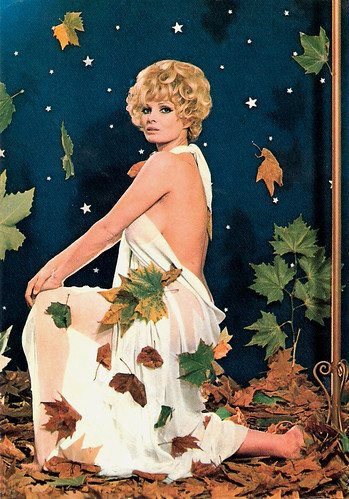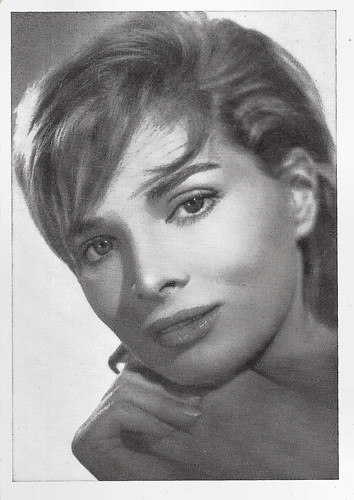Italian starlet Scilla Gabel (1938) often played the damsel in distress in peplums, the Italian sand and sandal epics of the late 1950s and 1960s. With her perfect body and face, she was a look-a-like for Sophia Loren. Between 1954 and 1982, the blue-eyed redhead appeared in 50 European and Hollywood films.

West German postcard by Ufa, no. FK 4000. Photo: Prisma-Film. Publicity still for Filles de nuit/Girls of the Night (Maurice Cloche, 1958).

Italian postcard by SAG, Trieste, Serie 27/1. Sent by mail in 1975.

Italian postcard, no. 609.
Scilla Gabel was born as Gianfranca Gabellini in Rimini, Italy in 1938. She studied acting at the Accademia Nazionale d'Arte Drammatica in Rome.
In 1954 she made her film debut in the drama Tua per la vita/For Your Life (Sergio Grieco, 1954) starring Gaby André. The press compared her to Sophia Loren, and she even worked as La Loren’s double on Boy on a Dolphin (Jean Negulesco, 1957). Gabel had two cosmetic operations that left her face distinctly different from her famous look-a-like.
Her breakthrough came with the Italian TV film Capitan Fracassa/Captain Fracasse (Anton Giulio Majano, 1958) with Lea Massari. She had a supporting part in Tarzan's Greatest Adventure (John Guillermin, 1958), featuring muscleman Gordon Scott in his fourth screen appearance as Edgar Rice Burrough's lord of the jungle. The cast also included Anthony Quayle and Sean Connery.
Hal Erickson at AllMovie: “While perhaps not as great as the title proclaims, Tarzan's Greatest Adventure is one of the most consistently exciting entries in the Tarzan series, and worth a second glance today due to its top-drawer supporting cast.” She next appeared as a princess opposite another muscleman, Steve Reeves, in the spectacle Agi Murad, il diavolo bianco/The White Warrior (Riccardo Freda, 1959), an adaptation of Leo Tolstoy's 19th-century-set novel, a courageous mountain warrior leads his band in a battle against the Czar.
In the French-Italian Gothic Horror Il mulino delle donne di pietra/Mill of the Stone Women (Giorgio Ferroni, 1960), she played the beautiful daughter of a mad professor, who suffers from a rare blood disease and is not allowed to leave her house. The international cast included Pierre Brice, Dany Carrel and Herbert A.E. Böhme.

Yugoslavian postcard by Ifis - Glas Smederevo, Serie 27/5.

Italian postcard by SAG, Trieste, Serie 29.

Italian postcard by SAG, Trieste, Serie 29.
During the early 1960s, Scilla Gabel starred in many Peplums, the popular Italian Sand and Sandal Spectacles. She played a princess opposite bodybuilder Mark Forrest in the Peplum Maciste, il gladiatore più forte del mondo/Colossus of the Arena (Michele Lupo, 1960). Then she starred opposite Roger Moore in Il ratto delle Sabine/The Rape of the Sabine Women (Richard Pottier, 1961).
One of Gabel’s best-known films is the biblical epic Sodom and Gomorrah (Robert Aldrich, 1962), starring Stewart Granger, Pier Angeli and Anouk Aimée. Mike Cummings at AllMovie: “The sets, costumes, and action scenes are more Hollywood than history - a veritable glitzkrieg of images - and modern viewers may balk at the chintzy special effects (…). The quality of the acting ranges from masterly to moronic.”
She then played another damsel in distress in the Peplum La Vendetta di Spartacus/The Revenge of Spartacus (Michele Lupo, 1962) featuring ‘beefsteak’ Roger Browne. Hal Erickson about the director: “He of the ‘Shout 'action', close your eyes and hope for the best’ school of filmmaking. If you don't like the action highlights, you'll get a thrill out of watching the actors flap their mouths in a Babel of foreign languages while the English soundtrack tries to keep pace.”
Gabel had a supporting role in the psychedelic spy spoof Modesty Blaise (Joseph Losey, 1966) featuring Monica Vitti. Production designers Richard Macdonald and Jack Shampan and costume designers Beatrice Dawson and Douglas Hayward created a masterpiece of 1960s ‘mod,’ but the screenplay was a muddle. Her career dwindled off after that.
One of her last great roles was Helen of Troy in the miniseries L'Odissea/The Odyssey (Franco Rossi, Piero Schivazappa, Mario Bava, 1968) starring Bekim Fehmiu and Irene Papas. During the 1970s, Gabel only played in a handful of feature films. On TV she appeared in the miniseries Dov'è Anna?/Where is Anna? (Piero Schivazappa, 1986). She retired after another TV mini-Series Festa di Capodanno/New Year's Eve (Piero Schivazappa, 1988). In the 1950s, Scilla Gabel had a brief affair with singer Fred Buscaglione, but since 1968 Scilla Gabel has been married to Piero Schivazappa, the director of her final TV productions. They have one son, Emiliano (1974).

German cigarette card. Photo: Jiano.

Italian postcard, no. 622.

Italian postcard by Bromofoto, Milano, no. 1653.
Source: I.S. Mowis (IMDb), Hal Erickson (AllMovie), Mike Cummings (AllMovie), Wikipedia (Italian, German and English) and IMDb.
This post was last updated on 26 April 2024.

West German postcard by Ufa, no. FK 4000. Photo: Prisma-Film. Publicity still for Filles de nuit/Girls of the Night (Maurice Cloche, 1958).

Italian postcard by SAG, Trieste, Serie 27/1. Sent by mail in 1975.

Italian postcard, no. 609.
A Princess Between Musclemen
Scilla Gabel was born as Gianfranca Gabellini in Rimini, Italy in 1938. She studied acting at the Accademia Nazionale d'Arte Drammatica in Rome.
In 1954 she made her film debut in the drama Tua per la vita/For Your Life (Sergio Grieco, 1954) starring Gaby André. The press compared her to Sophia Loren, and she even worked as La Loren’s double on Boy on a Dolphin (Jean Negulesco, 1957). Gabel had two cosmetic operations that left her face distinctly different from her famous look-a-like.
Her breakthrough came with the Italian TV film Capitan Fracassa/Captain Fracasse (Anton Giulio Majano, 1958) with Lea Massari. She had a supporting part in Tarzan's Greatest Adventure (John Guillermin, 1958), featuring muscleman Gordon Scott in his fourth screen appearance as Edgar Rice Burrough's lord of the jungle. The cast also included Anthony Quayle and Sean Connery.
Hal Erickson at AllMovie: “While perhaps not as great as the title proclaims, Tarzan's Greatest Adventure is one of the most consistently exciting entries in the Tarzan series, and worth a second glance today due to its top-drawer supporting cast.” She next appeared as a princess opposite another muscleman, Steve Reeves, in the spectacle Agi Murad, il diavolo bianco/The White Warrior (Riccardo Freda, 1959), an adaptation of Leo Tolstoy's 19th-century-set novel, a courageous mountain warrior leads his band in a battle against the Czar.
In the French-Italian Gothic Horror Il mulino delle donne di pietra/Mill of the Stone Women (Giorgio Ferroni, 1960), she played the beautiful daughter of a mad professor, who suffers from a rare blood disease and is not allowed to leave her house. The international cast included Pierre Brice, Dany Carrel and Herbert A.E. Böhme.

Yugoslavian postcard by Ifis - Glas Smederevo, Serie 27/5.

Italian postcard by SAG, Trieste, Serie 29.

Italian postcard by SAG, Trieste, Serie 29.
Sand And Sandal Spectacles
During the early 1960s, Scilla Gabel starred in many Peplums, the popular Italian Sand and Sandal Spectacles. She played a princess opposite bodybuilder Mark Forrest in the Peplum Maciste, il gladiatore più forte del mondo/Colossus of the Arena (Michele Lupo, 1960). Then she starred opposite Roger Moore in Il ratto delle Sabine/The Rape of the Sabine Women (Richard Pottier, 1961).
One of Gabel’s best-known films is the biblical epic Sodom and Gomorrah (Robert Aldrich, 1962), starring Stewart Granger, Pier Angeli and Anouk Aimée. Mike Cummings at AllMovie: “The sets, costumes, and action scenes are more Hollywood than history - a veritable glitzkrieg of images - and modern viewers may balk at the chintzy special effects (…). The quality of the acting ranges from masterly to moronic.”
She then played another damsel in distress in the Peplum La Vendetta di Spartacus/The Revenge of Spartacus (Michele Lupo, 1962) featuring ‘beefsteak’ Roger Browne. Hal Erickson about the director: “He of the ‘Shout 'action', close your eyes and hope for the best’ school of filmmaking. If you don't like the action highlights, you'll get a thrill out of watching the actors flap their mouths in a Babel of foreign languages while the English soundtrack tries to keep pace.”
Gabel had a supporting role in the psychedelic spy spoof Modesty Blaise (Joseph Losey, 1966) featuring Monica Vitti. Production designers Richard Macdonald and Jack Shampan and costume designers Beatrice Dawson and Douglas Hayward created a masterpiece of 1960s ‘mod,’ but the screenplay was a muddle. Her career dwindled off after that.
One of her last great roles was Helen of Troy in the miniseries L'Odissea/The Odyssey (Franco Rossi, Piero Schivazappa, Mario Bava, 1968) starring Bekim Fehmiu and Irene Papas. During the 1970s, Gabel only played in a handful of feature films. On TV she appeared in the miniseries Dov'è Anna?/Where is Anna? (Piero Schivazappa, 1986). She retired after another TV mini-Series Festa di Capodanno/New Year's Eve (Piero Schivazappa, 1988). In the 1950s, Scilla Gabel had a brief affair with singer Fred Buscaglione, but since 1968 Scilla Gabel has been married to Piero Schivazappa, the director of her final TV productions. They have one son, Emiliano (1974).

German cigarette card. Photo: Jiano.

Italian postcard, no. 622.

Italian postcard by Bromofoto, Milano, no. 1653.
Source: I.S. Mowis (IMDb), Hal Erickson (AllMovie), Mike Cummings (AllMovie), Wikipedia (Italian, German and English) and IMDb.
This post was last updated on 26 April 2024.
1 comment:
Play Boy sept. 1963?
Post a Comment